JUST OFF THE SHORELINE, cutthroat trout are feeding noisily on the surface. I wade a few steps into a muck-fest and look over my shoulder at the wall of subalpine fir, red willow, and mountain ash that has the lake hemmed in. With no room behind me, I shake out some line, unfurl a roll cast, and watch my double-dry-fly rig—a size 14 Purple Haze behind a size 12 Humpy—float on a glasslike surface that’s incongruous in this high country, where, usually, the wind gets its mail.
We’ve passed a hundred places already where we could have stopped and taken stock of why we’re here, but none so far is better than this one. I spot Trevor Hubbs and DJ Zor ease out of the thicket wall off to my right, both focused on a pod of fish that are dimpling the surface and porpoising in a maddening way. Fixated on their luck instead of my own, I miss a hard hit on the Purple Haze and cuss too much within earshot of Jane Armstrong, the young woman leading our merry band on behalf of the Bob Marshall Wilderness Foundation, who does not yet fly fish and seems to be having a hard time understanding why we were all so intense, whining like chained dogs at the feeding trout out here.
Finally, Trevor lands a decent fish—a heavy 12-inch cutthroat, speckled beautifully with the strange dark planets and starbursts of blue and black and the blood-red slash marks below the gills that give the species its name. Our photographer, Aaron Agosto, hooks a small one, whose surface thrashing makes the dark bar of a big fish visible through the tannin stain of the lake water. Then it fades again into the darkness. We’d all like to stay longer, but we’ve got a job to do, and there’s still a long way to go.
Into the Bob
We’re hiking into the Bob Marshall Wilderness, known to Montanans simply as “the Bob.” Since morning, we’ve gained 2,100 feet and covered 5½ miles, and there’s another 9 miles ahead before we reach our camp on Shaw Creek. DJ shoulders the big, springy two-person crosscut saw over his shoulder. We’re all here as volunteers to clear access trails and do whatever other public-lands tasks need doing. We were supposed to be a larger merry band. Trevor and DJ are veterans—an Army paratrooper and Navy submariner, respectively—and had recruited several other willing vets to fish, camp, see the wilderness, and help with the work. But the price of flights had shot up like 4-ounce bottle rockets, and plans, as they will, fell through. We joked that the missing vets had googled “crosscut saw” and suddenly remembered other pressing commitments. But we agreed that if they’d known about the lake and the cutthroats, a few more would have made it. As it is, we are a smaller but tighter-knit group, with more trout for each of us.

Navy vet DJ Zor, a volunteer with the Armed Forces Initiative, carries a two-man crosscut saw through Gordon Pass toward Waldbillig Mountain. (Photo: Aaron Agosto)
Other than the big saw, we are traveling light, because Jane and the Bob Marshall Foundation—a nonprofit group whose mission is to connect people with the wilderness and help volunteers with stewardship projects like this one—contracted with two packers and packhorses to carry our other gear and provisions to the US Forest Service cabin on Shaw Creek, where we can use the stove and take shelter if the weather goes the way it often does in the Bob.
We trudge. The trail rises to Gordon Pass, a divot in the wall of peaks, overhung by the spectacular 8,300-foot Waldbillig Mountain, with a snow-filled gully running like a lightning bolt down its face and with cornices of snow near its summit. All of it is melting in the mid-July heat, waterfalls pouring down acres of sheer stone polished by thousands of such summers. The roar and hiss of the waters comes to us from the faraway face, echoing off the mountain behind us, a music like nothing humankind could ever make. The pass opens in front of us onto the vastness of Gordon Creek valley, leading to the South Fork of the Flathead River 20 miles and more in the distance. Beyond that, over another range of mountains, the Bob Marshall Wilderness stretches for another 30 miles or so, making it one of the largest roadless areas in the lower 48 states, and one of the most wildlife-rich landscapes on earth.
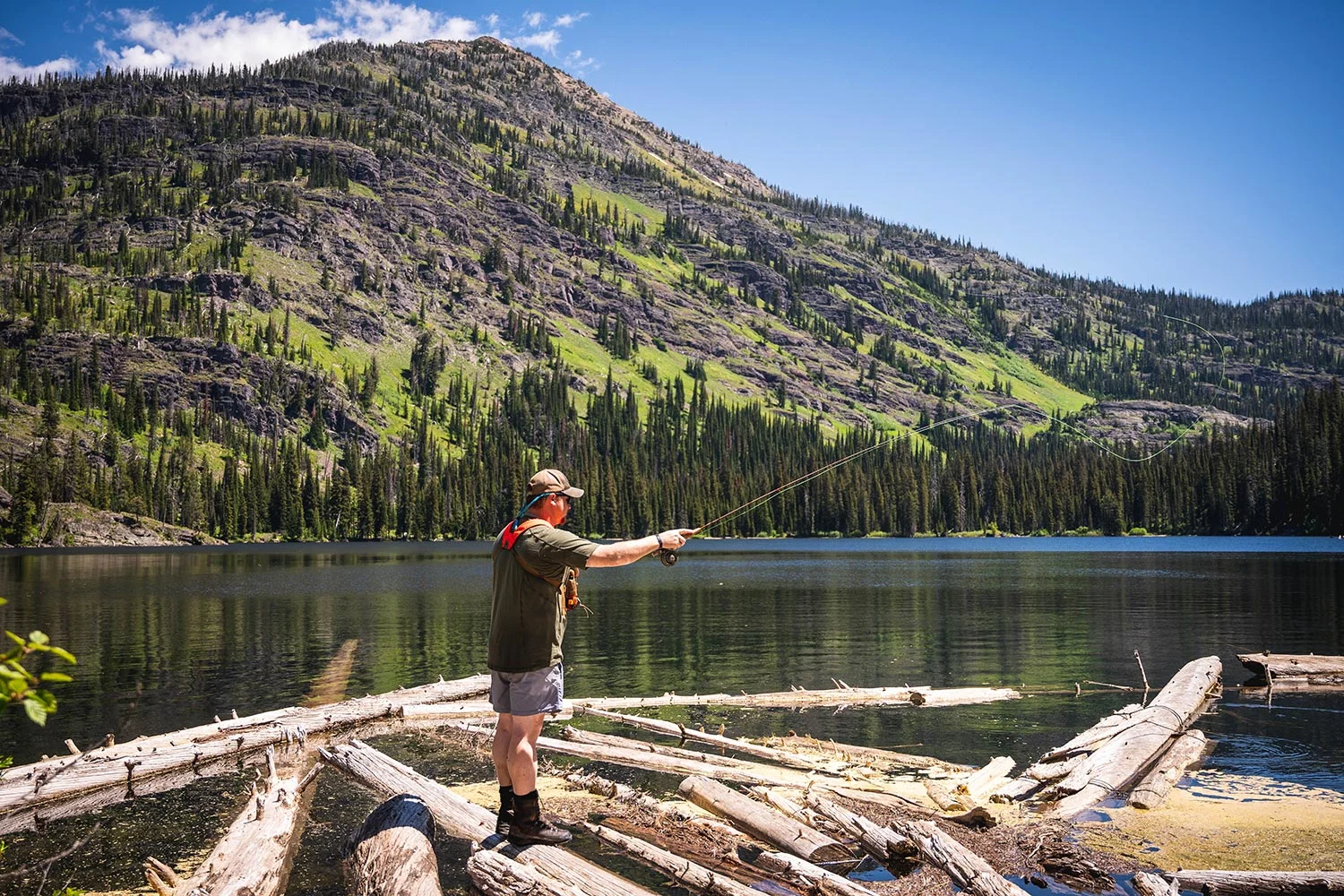
Hubbs inches out onto a logjam to reach cutthroat trout dimpling the surface near the outlet of Upper Holland Lake. (Photo: Aaron Agosto)
A Different Way to Serve
Trevor Hubbs directs the Armed Forces Initiative (AFI) for the conservation group Backcountry Hunters & Anglers (BHA). I met Trevor when I interviewed him for the BHA podcast, which I host. He grew up hunting and fishing in southern Illinois and Missouri, and now lives in Hartford, Wisconsin, because his wife is from there, and with two young children, they wanted to be closer to her family. Trevor served seven years in the US Army as an airborne infantryman, attaining the rank of sergeant. The Army had always been his goal, and he went in right after high school. He would still be there, but an accident while jump-training stateside led to a series of health issues culminating in a kidney transplant.
He was lucky to be alive, but his military career was effectively finished. Instead of going to the Middle East with his troops, he served stateside with the Illinois National Guard, commanding an eight-man heavy-weapons squad, until he received an honorable discharge from the service to which he’d planned to devote his life. “It was nobody’s fault, just an incident,” he tells me. “But everything changed for me.” He went to college and got a degree in U.S. history, then his master’s in business management. He was building a successful career as a business consultant but couldn’t shake the feeling that he had a mission that had not been completed.
“I needed to find a different way to serve,” he says. “Maybe it was survivor’s guilt. I know a lot of guys who didn’t make it back, and some of the ones who did have had a hard time. Because I was injured, I wasn’t able look out for my men over there, but I can look out for them when they get back.”
Our country was at war for more than 20 years following 9/11, the longest continued military engagement in US history. “A lot of Americans gave their lives to this, literally,” Trevor says. “Thousands of others have been injured or suffer from post-traumatic stress disorder, TBI, depression, or a combination of those. Many servicemen and -women just have real trouble transitioning to civilian life. One universal thing we all hear is, ‘I just feel better outdoors.’”
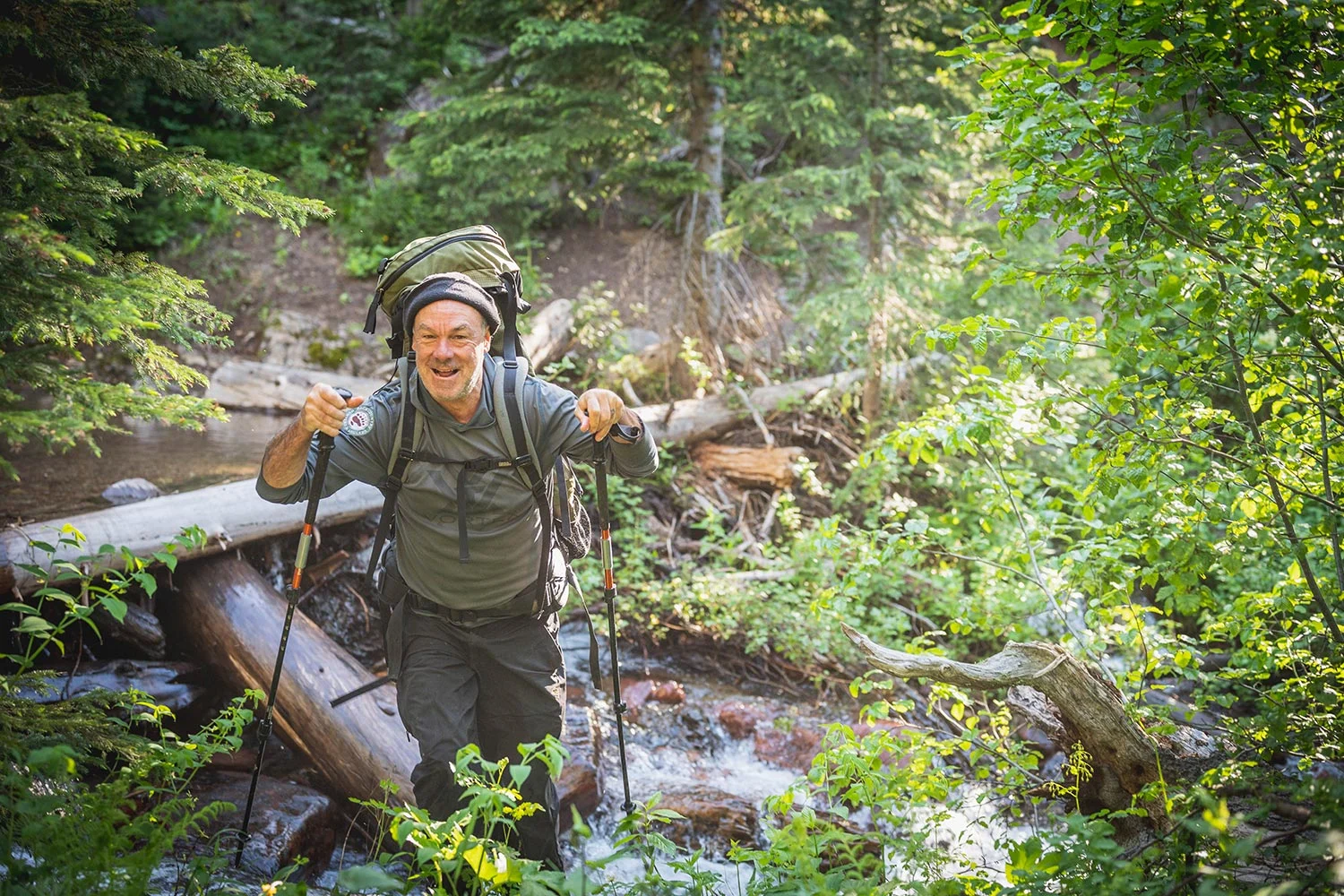
The author crosses a mountain stream while hiking toward Gordon Pass. (Photo: Aaron Agosto)
Since starting as a volunteer with the AFI in 2020, Trevor has made it his life’s work to help those folks feel better. “When I came on as a staffer for the BHA, my goal was to get 1,700 service people involved. We’ve got 11,471 now. We run 102 wilderness and hunting camps across the country.” Right now, the AFI is operating in 41 states, with clubs on 26 active military installations, engaging veterans, active-duty soldiers, reservists, and National Guard troops. “Pretty amazing, considering that we started in 2020 with 18 veterans in eastern Montana chasing mule deer,” Trevor says. “We are doing some big trips (canoeing the Boundary Waters, some salmon fishing in Alaska), but most of what we do is everyday hunting and fishing—muzzleloader whitetails, Texas turkeys, bass fishing,” Trevor explains. “It is not about a once-in-a-lifetime hunting or fishing trip. It is about getting people into a lifetime of hunting and fishing.”
Freedom’s Fee
We descend from the pass down a long set of switchbacks winding through a riot of head-high greenery—thimbleberry, false huckleberry, elderberry. Beargrass is blooming everywhere, its big white flowers like lit torches along avalanche chutes and in the gloom of the forest. We hit Shaw Cabin just as the daylight shifts to the gloaming of summer twilight, bats hunting bugs in shafts of waning sunlight.
Our packers, Wendy and Bonnie, both in their 60s and with a few decades of wilderness packing and riding between them, are already here and have kicked back on the porch of the cabin, the horses unloaded and turned out for grazing, all our gear laid out neatly for us. They will leave at first light tomorrow and come back to pick up our loads in a few days, when our work is done.

The rendezvous at Shaw Cabin. From left to right: DJ Zor, Trevor Hubbs, the author, Bonnie Pollock, Wendy Montfort, and Jane Armstrong. (Photo: Aaron Agosto)
Tents pitched and dinner down, we gather around a table and study my old paper map of where we are and what trails we plan to clear, what hidden lakes we want to fish, what dreams we might have of seeing more of this million acres of wilderness. There are few pleasures in this life that equal being free and well fed, on an adventure with good people, and 15 miles from the nearest road.
Such pleasures don’t come for free, though. The next day we head up the Shaw Creek Trail for a few miles, finding it mostly cleared by Forest Service crews. Eventually we find our own work; a tangle of deadfall spruce marks the spot where these crews must have turned around. DJ and I start with the two-man crosscut saw, and after a few minutes of figuring out the push-pull rhythm, the saw, meticulously sharpened by a practitioner of the lost arts, is sliding through the log, leaving long, flat curls of wood at our feet.

Zor plunges into Gordon Creek for a shot at some wild cutthroats. (Photo: Aaron Agosto)
Jane, Trevor, and Aaron climb over the biggest logs and cut the smaller stuff with the folding Silky saws that have become every wilderness traveler’s mainstay. Higher and higher we climb, sawing out a few big logs and a jigsaw puzzle of lodgepoles, until we reach a point where the creek becomes an alpine rivulet flowing in flats of mossy rock and meadows. We take a break to assemble pack rods and fish a few shallow pools with tiny terrestrials but strike out.
Despite a long hike back, we have more than enough energy left to make a run at Gordon Creek near camp. DJ and I thread a tangle of deadfall and heavy brush, looking for the water, which we can hear, hissing and tumbling out of sight behind a wall of red willow and alder. When we reach the water’s edge, we see that the creek is nearly flooded. We stand in the ice-cold water in sandals and shorts, enjoying the respite from the hiking and the heat, and we talk for a while.
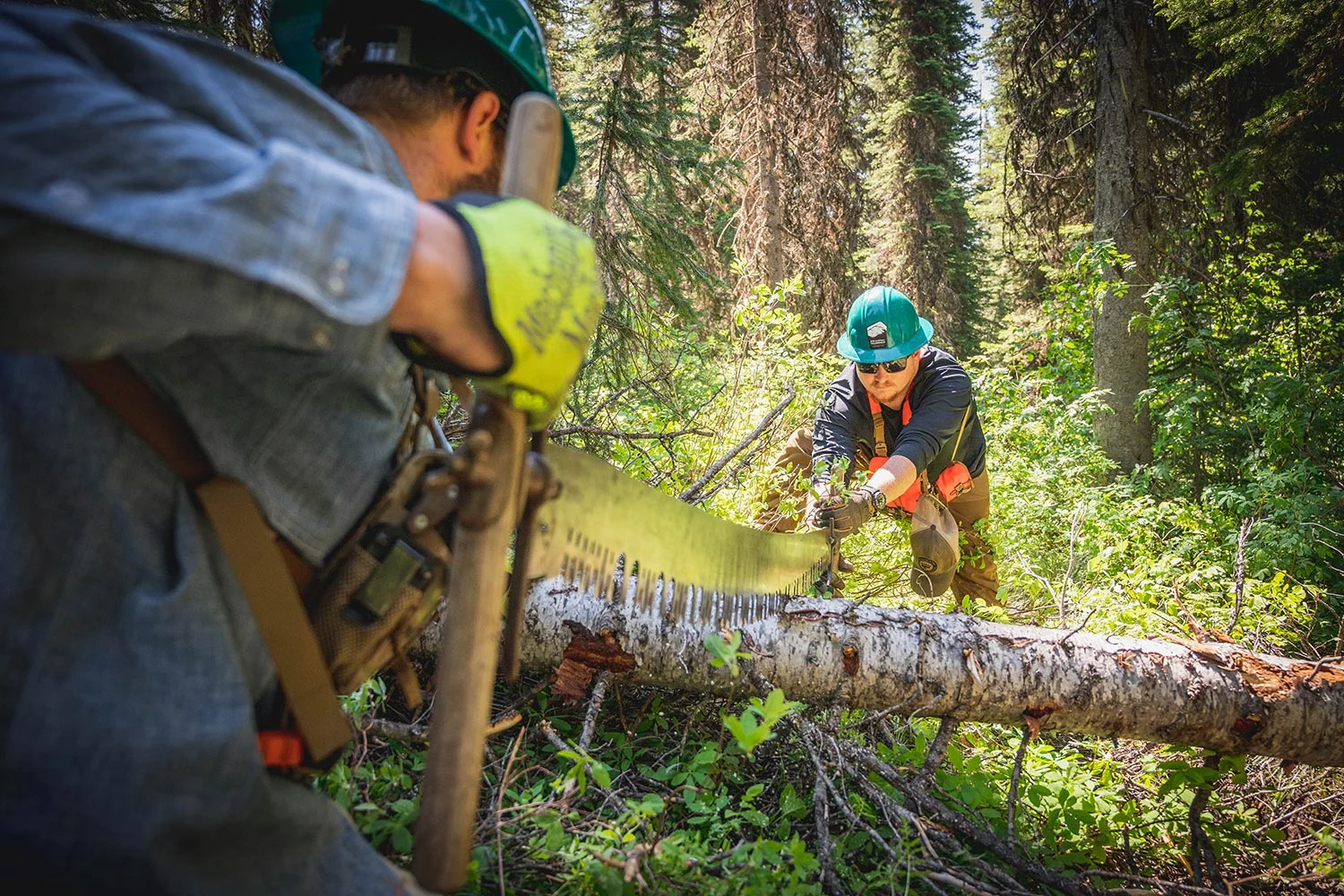
Zor and Hubbs work the crosscut saw, clearing deadfall along the trail. (Photo: Aaron Agosto)
DJ Zor is a volunteer with the AFI. He grew up hunting and fishing in Wisconsin with his grandpa, worked as a motorcycle mechanic in Florida before joining the Navy, and since he got out has run rivers in Alaska and killed elk in the Arizona high country and pronghorns in Wyoming with a bow. Using some of what he learned as a submariner, he got a job at a hydropower plant here in Montana and is now hunting forest turkeys and valley whitetails and planning wilderness elk and mule deer hunts. He’s a mountain man, bearded, intense, tattooed (including the sailor’s classics of a pig on the right foot and a chicken on the left), serious about his work and about being a father to his young daughter. I ask him what inspired him to put his very limited amount of free time into this effort. “‘I was born this way,” he says. “I always need a mission.”
He had a hard time after leaving the service. “It was a shocking transition,” he says. “Every day, for years, you wake up knowing exactly what is expected of you, and you do it. Then, as soon as you get out, all of that is just gone. It’s no mystery why it’s such a dangerous time—substance abuse, suicides, bad choices, you name it.” He says he floundered for far too long. “Finally, and luckily, I made a trip to Alaska with some friends that set my world back upright.”
On that trip, he was able to see his military service in an entirely new way. “I was looking at all that wild country up there, and thinking of all we have down here, and I realized that none of it exists by accident. It’s here because people have worked to keep it that way, or to protect the fish, or restore or protect the wildlife and the lands. That is something I can understand—conservation as a mission. I know so many vets and service members who love the outdoors, and we’ve already sworn the oath to protect this dirt we’re standing on. I got lucky. I figured that out, and my life has been better for it. Now I can connect service members, active or not, with that mission. It’s a natural fit, a way for us to keep serving our country.”
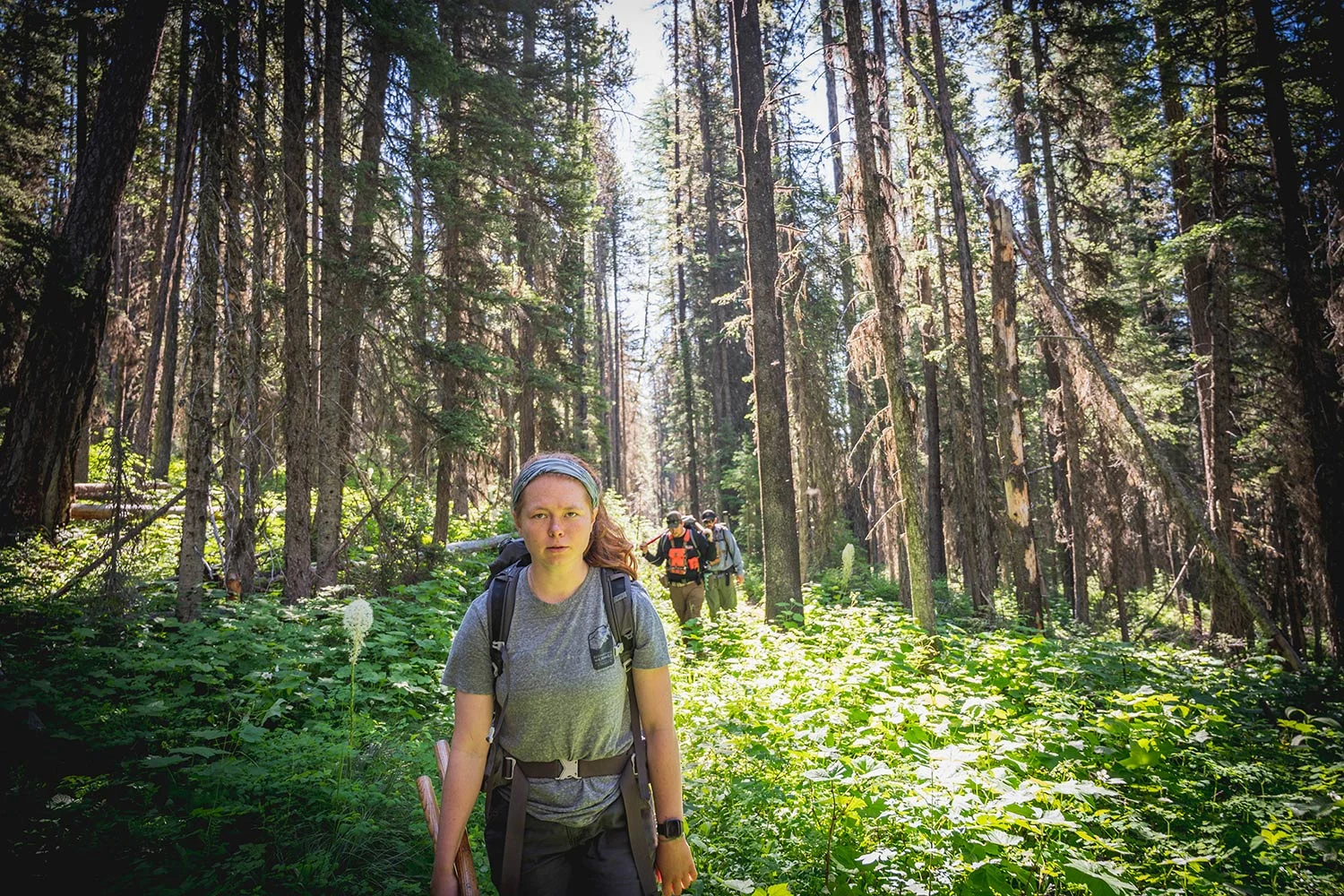
Armstrong, a trail-crew leader for the Bob Marshall Wilderness Foundation, breaks trail. (Photo: Aaron Agosto)
We hear Trevor and Aaron shouting upstream and figure at least one of them has found a fish. I make my way across the freezing torrent, and DJ wades around the alders and slingshot-casts to an eddy under the roots of a big spruce. By the time I get across, I’m so cold that the fishing seems almost too much to pursue. I find a column of strong sunlight, crawl out of the water, and just lie there for a while, soaking it up. I manage one 8-inch cutthroat from a side slough before I give up and head, alone, for camp, singing my overly energetic version of “Stayin’ Alive” by the Bee Gees, which is a surefire grizzly bear repellent. The tally back at camp for all of us is three cutthroats caught and released, and an exhausting, freezing good time had by all.
Left Untouched
According to the packers, the real fishing is at Doctor Lake, an alpine jewel set in a basin under towering walls of stone and snow. We see it on the map. We know exactly where it is. We are going to clear the old trail to it, and then fish for massive naive cutthroat trout that may never have seen a fly or leader. We get an early start so we’ll have plenty of time for both work and fishing.
We find the trail and head upstream along a fork of Gordon Creek, a heavy pour of water that must be the outflow from Doctor Lake. The trail is good for a mile or so, and then we run into jumbles of deadfall almost too big for our crew. But we take turns on the crosscut and then move to the next pile of logs, which is only about 50 feet up the trail.
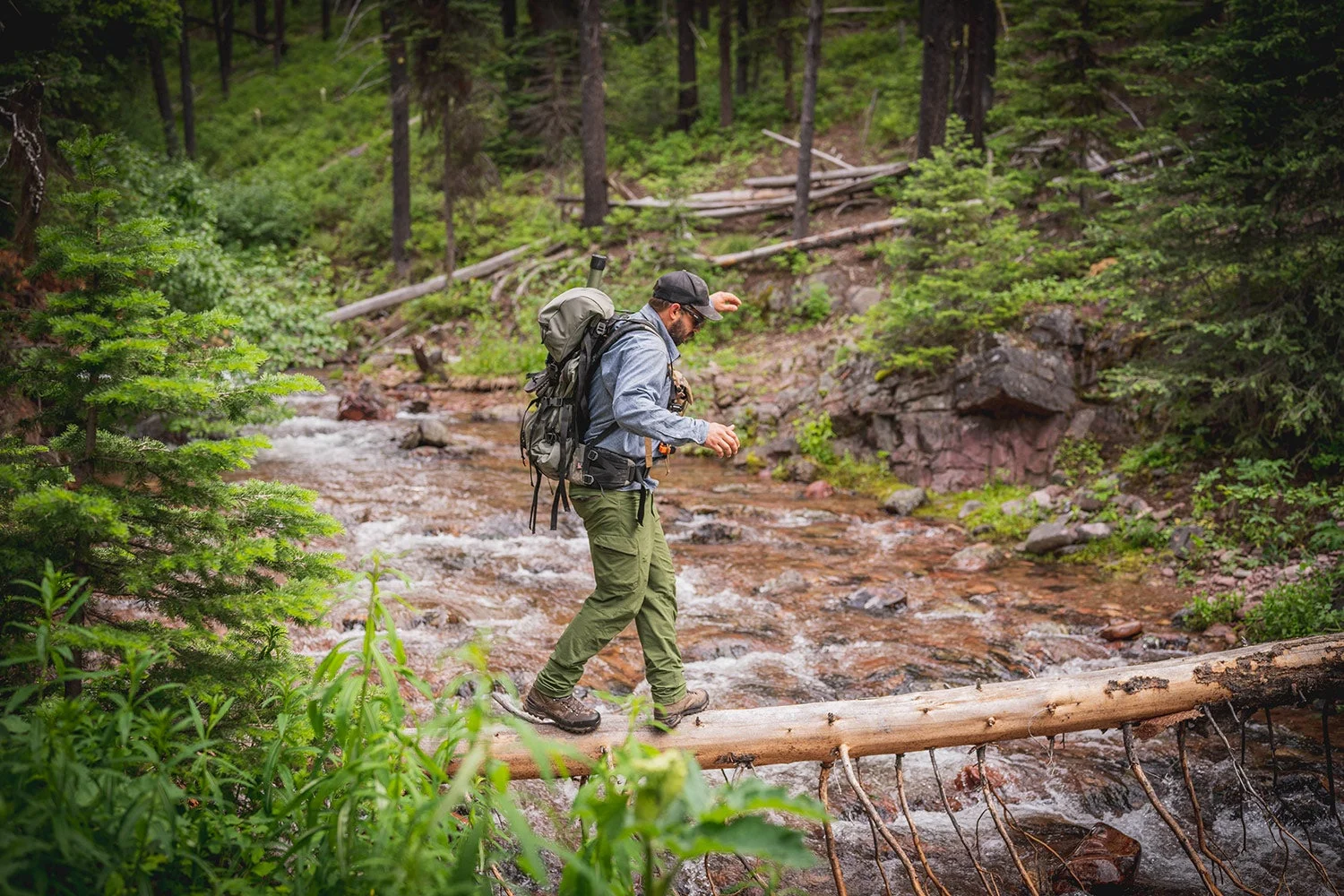
Zor balances his way across a downed tree high above Shaw Creek. (Photo: Aaron Agosto)
We decide to send Trevor and Aaron on a scouting mission for Doctor Lake. The two explorers bound away, and DJ, Jane, and I get back to sawing. An hour or two passes, slowly. It should be only a few miles to the lake. Where are Trevor and Aaron? We shout. We yodel. But it’s useless. The creek is raging through piles and piles of dead timber, frothing against rocks and sizzling through gravel bars. Nobody can hear much of anything. In horror-movie fashion, where the actors disappear one by one, we send Jane to find the missing explorers. More time passes. Columns of caddisflies revolving in the sunlight over the creek make us yearn even more for the fishing. Eventually, DJ and I stash the saws, shoulder our packs, and head upstream too.
This is the forest primeval, much of it dead and fallen. We find Jane on a giant spruce log that straddles the creek banks 10 feet above the water, strewn with what looks like avalanche debris, through which the torrent is madly flowing. It’s a beautiful, utterly inhospitable, nearly impossible place. The trail is nowhere to be found. Trevor and Aaron suddenly appear at the far end of the spruce log and walk the narrow bridge of its length to reach us.
“Where’s that lake?” DJ says.
“We have no idea,” answers Trevor. He and Aaron are brush-whipped and soaked, having been in the creek, for want of a trail, climbing over and under fallen logs.
“You can’t get there from here,” Aaron says sadly. “We went as far as we could, and started running into fresh grizzly shit too.” We ponder this. The sun is sinking, too near the jagged crest of the mountain walls above us. The quest, for now, is over.
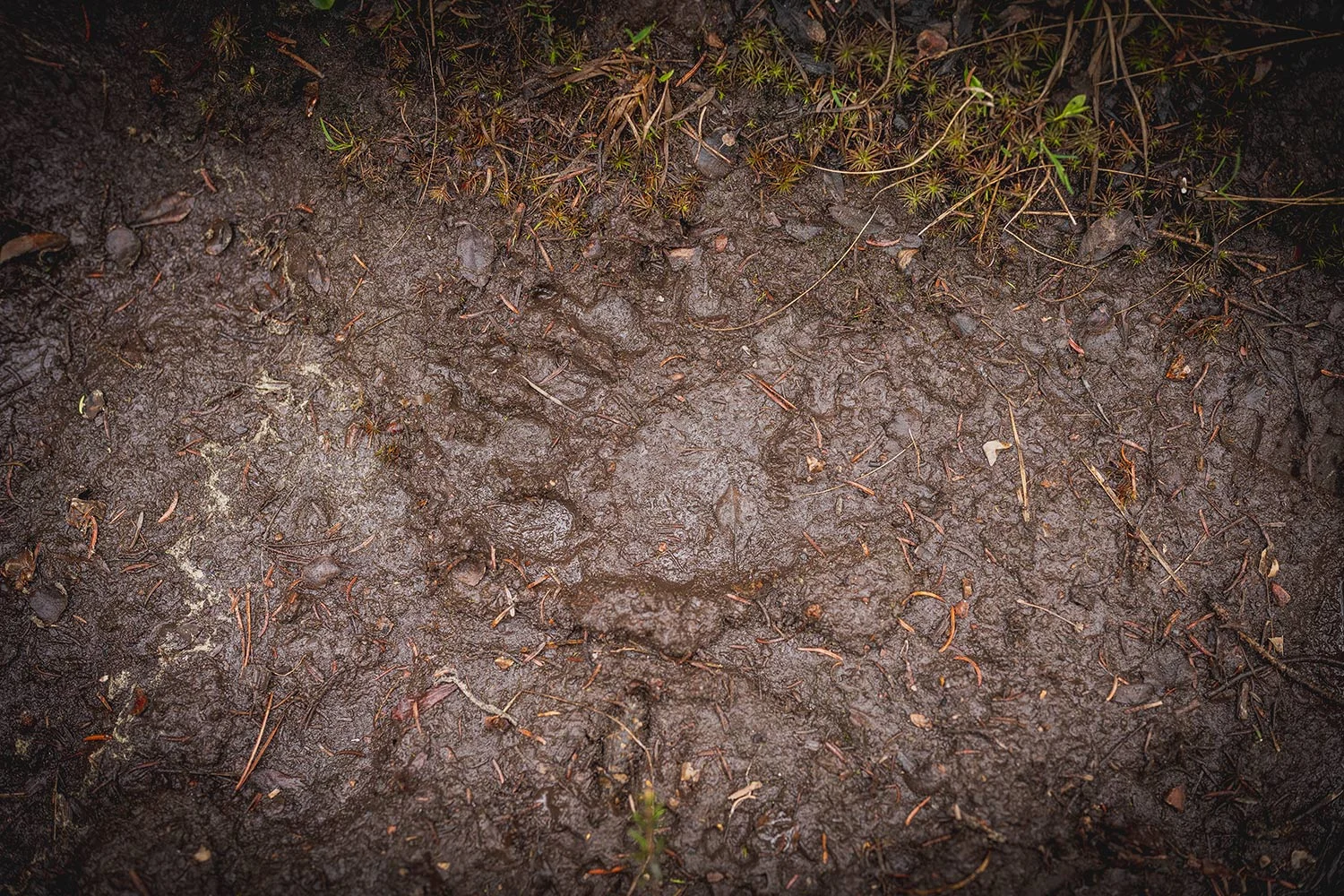
A grizzly track gets the hikers’ attention. (Photo: Aaron Agosto)
It is a long walk back to camp, exhaustion nipping at our heels and miles of morale-busting hills ahead. But nothing is lost. Success is measured in different ways in the wilderness, and in a place like this, you don’t always get exactly what you came for on your first try.
Someday we’ll come back with some of the veterans who couldn’t make this trip, and we’ll clear that trail, with a proper crew, all the way to Doctor Lake. Mythical giant cutthroats will become real, rising to flies we haven’t tied yet. The old-growth timber and wilderness will still be here; the creek will run freezing cold and clear as ether; the grizzlies will be lurking and the beargrass blooming. In the meantime, with our work done for now, there are cutthroats in the lake below that we didn’t have time to catch earlier.
How to Get Involved
If you are a veteran or active-service member and interested in the outdoors, don’t wait any longer. This year the AFI will be hunting pronghorns in Montana and elk in Colorado; ice fishing for walleyes, pike, and perch out of Minot, North Dakota; fishing for big redfish in the marshes of Louisiana; hunting whitetails in Wisconsin and North Carolina; spearfishing in California; running dogs for quail in New Mexico; shooting snow geese in Arkansas; and hunting late-season black ducks in Massachusetts. Join them if you can.
This story was originally published in 2022.






